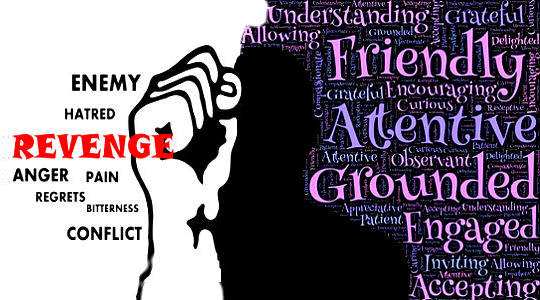
Use the Teflon side of your mind, not just the Velcro side.
— Lama Surya Das, Words of Wisdom
Much of our pain comes from the emotional clutter of resisting or hardening ourselves against the way things are. For example, how often do you resist what appears before you during an average day? Suppose you’re stuck at a stoplight and late for work. Do you get anxious or frustrated and blame the red light and drivers for conspiring to make you late?
Imagine you’re in the line at the grocery store and someone pulls out a whopping stack of coupons at the last second. Do you lose patience, roll your eyes, and curse your fate — or maybe curse the coupon shopper?
Or perhaps you observe a lackadaisical coworker who doesn’t care or works only half as hard as you do. Do clutter feelings of anger and resentment stick to you like Velcro?
Do you resist the fact that you have debts to pay? Do you resist that you don’t have the career or life that you dream of? Do you blindly respond to new situations in old ways, rather than get playful and flexible?
The Challenge of Reacting to Difficult Daily Events
Reacting to difficult daily events, whether minor or major, can be a challenge. That is, until we learn how to soften. It’s not that life is conspiring to annoy and thwart us. Rather, when we mindlessly want reality to conform to our own limited mindsets, fixed categories, blind routines, rigid contexts, mental shortcuts, and narrow perspectives, this is what causes unwarranted and often inexhaustible mounds of needless emotional clutter to pile up.
Softening means that you can bend and not break; it means having an attitude of openness, willingness, and acceptance toward what life throws at you. The more pliable you are, the more you are able to change course and roll with life’s punches — instead of throwing punches.
Transform Velcro Thinking Into Teflon Thinking
While following generational mindsets or rituals without questioning them may give us a sense of belonging, there are times when Velcro thinking — being stuck in a robot-like mindset — may actually affect our health and how we feel and think about ourselves.
Fixed ideas about aging are an example of how easily we can get stuck — individually and culturally. In her book Mindfulness, social psychologist and mindfulness researcher Ellen Langer described various studies about aging that she conducted — studies that explored the psychological and physical effects of switching from negative Velcro thinking about age to more flexible Teflon thinking. Could a more Teflon-like perspective about age bring our bodies to a more youthful state?
To find out, Langer recruited men who were between seventy-five and eighty years old. The men were placed into one of two groups. The experimental group attempted to re-create and act like the person they were twenty years earlier, when they were fifty-five years of age. The second group — the control group — merely thought about the past as it had been twenty years prior.
To help the experimental group embrace the context of when they were fifty-five years old, the men were brought to a rural retreat center for five days. Everything in the retreat center — the TV programs, advertisements, radio programs, magazines, and music — was just as it had been twenty years earlier. The men were encouraged to talk about this context as being the present moment rather than thinking of it as the past. This group watched films from that year and had discussions about them. They also were encouraged to do things for themselves — such as taking care of their own luggage — just as they had done when they were fifty-five years old.
A visual recording was taken of subjects in both groups. This tracked posture, movement, and gait both at the beginning of the study and at the end, as well as a number of physical measurements. Independent judges even looked at before-and-after pictures of their faces to rate the ages of the men in the study.
There were significant changes between the two groups after only five days. The judges rated the experimental group as looking an average of three years younger after just one week. Other physical changes for the experimental group (as compared to the control group) included better hearing, increased flexibility and manual dexterity, greater finger length, improved eyesight, and even improved height while sitting. The experimental group also showed significant improvements in an intelligence test that was given to both groups.
In Mindfulness, Langer concluded, “The regular and ‘irreversible’ cycles of aging that we witness in the later stages of human life may be a product of certain assumptions about how one is supposed to grow old. If we didn’t feel compelled to carry out these limiting mindsets, we might have a greater chance of replacing years of decline with years of growth and purpose.” These stunning findings suggest the importance of being more flexible in how we think about ourselves.
Einstein's "What If" Exercises
Einstein used mental “what if” exercises to help him think about relativity in fresh, new ways, and we can teach our minds to be more flexible and Teflon-like using similar exercises. Teflon thinking could also be extended to the attitude you take toward any situation.
Think of how you automatically respond to a daily challenge, such as morning rush hour. How many ways can you finish the following sentence?
My attitude toward rush hour could be _____.
From the Teflon perspective, your attitude toward rush hour could be many things — acceptance, fascination, amusement, self-compassion, compassion for others, willingness, and gratitude for having a place to go to during rush hour.
Now consider some other could be scenarios.
- My attitude toward my marriage/my relationship/my children could be _____.
- My attitude toward my job could be _____.
- My attitude toward anxiety could be _____.
- My attitude toward my need for control could be _____.
Sometimes, there’s an unconscious or unintended benefit to our Velcro thinking. For one thing, we know exactly what to expect. There’s also the emotional charge that comes from feeling righteous and angry about situations that are out of our control — and yet this gives us a false sense of power and mastery.
When impossible things happen in the world and in our lives, it may feel like it’s easier to ignore or rail against the truth of life’s messiness than to accept it. In the long term, though, this just produces a suffocating wall of emotional clutter.
Daily Affirmations For Breaking Free From Velcro Thinking
A study published in the journal Proceedings of the National Academy of Sciences examined how negative or positive thinking affects immune system function. More specifically, the researchers wanted to measure whether those individuals who had high levels of activity in the left prefrontal cortex — which is associated with optimism and positive emotions — would display a greater immune system response when given a flu vaccination.
Fifty-two subjects were given several emotional memory tasks. By looking at the responses and the prefrontal cortex activity, researchers pinpointed individuals who tended to react pessimistically and those who reacted in a positive or optimistic way.
Next, all subjects were given a flu vaccine and were examined three times over a six-month period. This was done to record how many antibodies were in the blood — a measurement of the body’s immune response. The results clearly showed that people who had a more positive emotional style had a stronger immune response than did individuals who were negative. Richard Davidson, one of the study’s researchers, concluded, “Emotions play an important role in modulating bodily systems that influence our health.”
Dwelling On Negative Emotional Clutter?
Constant dwelling on negative emotional clutter, or Velcro thinking, creates a well-worn groove in the brain that plays over and over just like a favorite song — one that we now know affects the body’s health. Affirmations provide us with a means of blocking old negative songs while giving us a new and more positive tune to align with.
A new mental soundtrack, created through a conscious affirmation, holds the potential to transform both our emotional and immune response. At the same time, we need to catch those mind whispers — the very subtle and almost unconscious commands — that can sway us and cause us to act robotically.
As you think about using conscious affirmations, it’s important to feel any resistance you may have to them. Bringing any resistance into the light will help defuse it. It will also help you to understand just how deep and unyielding old emotional clutter can be.
In Scientific Healing Affirmations, spiritual teacher Paramahansa Yogananda recognized that potent, positive affirmations could be weakened or immobilized by background clutter. He wrote, “If you affirm ‘I am well,’ but think in the background of your mind that it is not true, the effect is the same as if you took a helpful medicine and at the same time swallowed a drug that counteracted the effects of that medicine.”
Rewiring Your Brain with Carefully Chosen Affirmations
A carefully chosen and caring affirmation can buffer you from negative clutter zones. As you rewire your brain in this way, you will sweep away rigidity while simultaneously inviting greater flexibility and receptivity into your life.
Here are a number of affirmations that you can try. Some can be used like mantras — sacred phrases that are repeated over and over. Others are simply ways of reminding ourselves of what we want and how we want to be in the world.
1. Affirmations of Personal Strengths and Qualities
- I am safe.
- I am intelligent.
- I am caring.
- I am calm.
- I am patient.
- I am a woman/man of great love and beauty.
- I am open and accepting.
- I am flexible and spontaneous.
- I am adventurous.
- I am peaceful.
- I am positive.
- I am inspiring, energizing, and activating.
- I am _______________.
2. Affirmations for Centering, Calm, and Acceptance
- Everything will get done.
- All you need is love.
- Give peace a chance.
- It is what it is.
- Just be me.
- I deserve the time and space to heal.
- Good enough is good enough.
Is There A Right Way to Use Affirmations?
Which of these affirmations resonate with you? You can write down your favorites on an index card and keep it with you. Or you can store favorites in your phone for reference throughout the day. There’s no right or wrong way to use affirmations.
There are affirmations for almost anything, from happiness to prosperity. You can also adapt any of the sayings above so that they feel right for you.
These affirmations just scratch the surface. It helps to make a habit of using affirmations. Notice how your thinking — and behavior — responds as you keep your affirmation firmly in mind.
©2016 by Donald Altman. Used with permission of
New World Library, Novato, CA. www.newworldlibrary.com
Article Source
 Clearing Emotional Clutter: Mindfulness Practices for Letting Go of What's Blocking Your Fulfillment and Transformation
Clearing Emotional Clutter: Mindfulness Practices for Letting Go of What's Blocking Your Fulfillment and Transformation
by Donald Altman.
Click here for more info and/or to order this book.
About the Author
 Donald Altman, MA, LPC, is a psychotherapist, a former Buddhist monk, and the award-winning author of several books, including One-Minute Mindfulness, The Mindfulness Toolbox, and The Mindfulness Code. He conducts mindful living and mindful eating workshops and retreats and trains mental health therapists and business people to use mindfulness as a tool for optimizing health and fulfillment. Visit his website http://www.mindfulpractices.com.
Donald Altman, MA, LPC, is a psychotherapist, a former Buddhist monk, and the award-winning author of several books, including One-Minute Mindfulness, The Mindfulness Toolbox, and The Mindfulness Code. He conducts mindful living and mindful eating workshops and retreats and trains mental health therapists and business people to use mindfulness as a tool for optimizing health and fulfillment. Visit his website http://www.mindfulpractices.com.




























